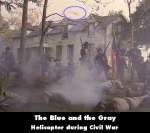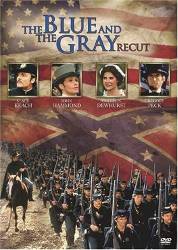
Visible crew/equipment: During the Battle of Bull Run, just before the first shell is fired towards the plantation house, at the upper part of the screen you can see a helicopter flying over the battle action. (01:45:00)

Continuity mistake: After the Battle of Bull Run, Jonas Steele is seen surveying the aftermath. Trouble is, there are a heck of a lot more dead bodies lying around outside the house than there were when the battle was raging, including those of Union soldiers. As the scenes of the battle demonstrated, the Union never actually got as far as the house; all their casualties were incurred on the slopes approaching the house, and then they retreated. (01:53:20 - 01:59:10)

Other mistake: A few times during the whole show there are certain shots where the corners of the screen are blacked out, as if a circular lens cap has been fitted to the camera. There seems to be no logical reason for this, therefore it has to be a mistake. One example is when Jonas is leaving his wife for the last time and he says 'there's a big battle brewing'. (00:07:25)
Factual error: Disc 2: There is a scene where a cannon shell explodes inside a hospital ward. Everyone in the ward is killed, but there are no signs of limbs torn off or even shrapnel wounds, only some blood here and there. The same thing happens at the Battle of Bull Run when the old woman gets blown out of her bedroom by cannon fire. (01:32:00)

Continuity mistake: Disc 2: When the Union soldiers cross the creek and the sergeant says 'you ain't even seen the elephant yet, lady', his troops are in a crouching position. But the next shot from the Confederate lines shows them standing up. (00:27:40)

Revealing mistake: When the coward is being branded using a red hot poker, you can see that the metal 'C' hasn't been heated at all when it is brought next to his face. Compare it to when they tested it on a piece of wood beforehand. The poker is also covered in a really fake-looking red paint. (02:02:55)
Factual error: When John meets a group of escaped slaves in the swamp, he gives them a newspaper clipping about the Emancipation Proclamation. The leader of the group calls it a message from "The White House." From the time it was built until President Theodore Roosevelt, the president's residence was known at "The Executive Mansion." It was President Roosevelt who changed the name to "The White House."
Continuity mistake: At the wedding of Jonas and Mary she is wearing a large hoop skirt, and also at their wedding reception she is wearing a hoop skirt under her dress. When they enter their carriage to leave on their honeymoon she struggles a little to get the hopped skirt into the carriage seat. When they arrive at their house to start their honeymoon she gets out of the carriage in the rain to run to the house and she is no longer wearing the hoop under her wedding dress. It is also missing when Jonas picks her up to carry her upstairs to the bedroom.






Answer: Stacy Keach, who portrayed Jonas Steele, is an imposing figure who stands just upwards of six feet tall. Julia Duffy, the actress who played Mary Hale Steele, is a diminutive five feet even - a full foot shorter than her on-screen husband. Though high heels have been around since the mid-16th century, the stiletto style heel didn't begin to come into play for fashion until the late 19th century, when they were mainly used as accessories in fetish art. They didn't become vogue for women's wear until the early to mid-20th century. It is unlikely a stiletto-style heel would have been available to, let alone be worn with a nightgown by a woman of the period.
Michael Albert